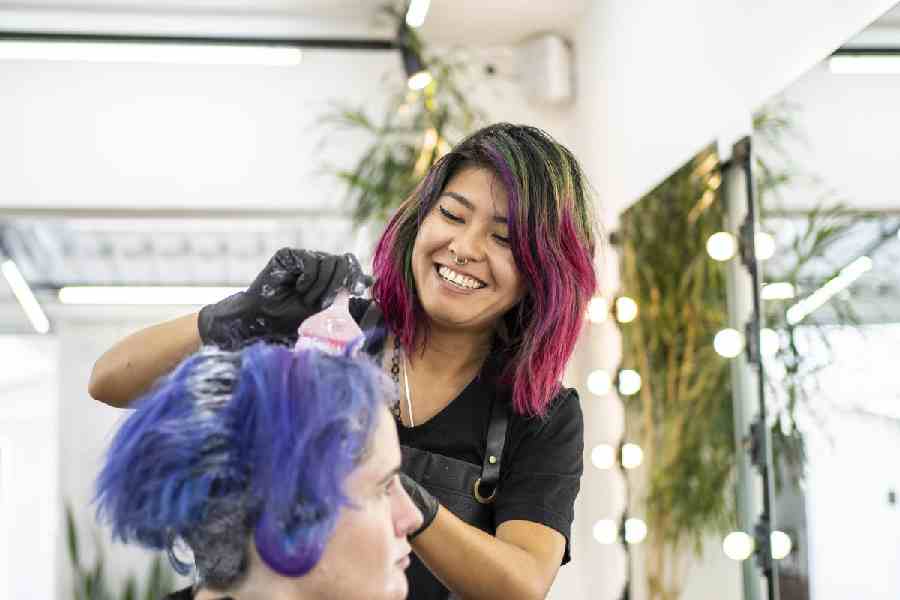Scientists have been looking into the association between hair dye and cancer for decades. And while some research suggests a link, the findings are mixed, making it hard to offer foolproof recommendations, said Alexandra White, a public health researcher at the National Institute of Environmental Health Sciences in the US.
Still, a closer look at the research could help you make an informed decision about what’s best for you and your hairstyle.
Much of the research on hair dye has focussed on its possible connection to bladder cancer — particularly among hairdressers exposed at work to permanent dyes made before the 1980s, said Dr David Goldberg, a researcher and dermatologist in New York City, US. The longer the hairdressers worked and were exposed via their skin or lungs, the more likely they were to develop bladder cancer.
But other studies have not found this increased risk, which could be because manufacturers began producing less toxic formulations after the 1970s.
Breast cancer does seem to be associated with permanent hair dye, though, White said. In a 2019 study involving more than 46,000 women, White and her colleagues found that those who used permanent hair dye frequently (every five to eight weeks) had a 9 per cent higher risk of breast cancer than those who didn’t use hair dye.
That may sound like a big jump, but it’s actually “a really small increase in breast cancer risk” when contextualised with a woman’s lifetime risk, White said. On average, women have about a 13 per cent chanceof developing breast cancer, soa 9 per cent increase of that value raises her lifetime risk only 1 percentage point to about 14 per cent.
When broken down by race, however, the risk for Black women was significantly higher, White said. Black women who coloured their hair frequently with permanent dye had a 60 per cent increase in breast cancer risk, raising their lifetime risk to nearly 21 per cent — compared with about 14 per cent for white women.
This link between permanent hair dye and breast cancer risk in Black women has been shown in other studies, too. It’s unclear what may be driving these racial and ethnic differences, said Dr Nada Elbuluk, an associate professor of dermatology at the Keck School of Medicine at the University of Southern California, US.
One possibility is that other hair products popular among Black women, such as chemical hair straighteners, relaxers and leave-in oils, may also play a role. But much more research is needed.
According to Goldberg, study findings may be mixed because the chemical combinations used in hair dyes can vary considerably between products, and they’ve evolved over the years. This makes it impossible to generalise about all hair dyes.
Unlike pharmaceuticals, White said, hair products are not strictly regulated. Manufacturers don’t need to prove that their products are safe before sale, and because their formulations are often proprietary, it can be difficult to know what’s in them.
However, one finding has been fairly consistent. Temporary and semi-permanent hair dyes, which wash out over time, seem to be much safer than permanent dyes, which cause lasting chemical changes in the hair shaft.
It’s challenging to know which specific chemicals could be driving the increases in cancer risk, White said. But research suggests that aromatic amines and phenols, found in permanent hair dyes, have carcinogenic effects.
Since no studies have proved that hair dye itself causes cancer, Elbuluk said, it’s up to you to decide if you want to continue your colouring routine, given any other potential risk factors you may have.
If you want to play it safe, consider these strategies:
nColour your hair less frequently. Though it’s not definitive that the more you colour your hair, the greater your breast cancer risk, “a goodprecautionary principle is to lower your frequency of use”, White said.
nAvoid permanent hair dye during pregnancy. It’s not certain that carcinogenic chemicals in hair dye may increase a developing foetus’s risk for cancer long term, but there is evidence that the chemicals may increase the chances of developmental problems. So it’s best for pregnant women to avoid using hair dye “at least for the first trimester”, Goldberg said.
nFollow colouring instructions carefully. When dyeing at home, wear protective gloves, apply the dye in a well-ventilated room, don’t leave it on your head for longer than the instructions indicate and rinse your scalp thoroughly when you’re done. This should help minimise your absorption of chemicals and lower the risk of skin irritation.
nTry dyes with gentler ingredients. Unlike permanent hair dyes, semi-permanent and temporary dyes contain chemicals that are less harsh and don’t penetrate the hair shaft. Safer yet: try a plant-based dye, such as henna, Goldberg said. Although these dyes don’t have the staying power of permanent dyes, they do not appear to be linked to cancer and are less likely than chemical dyes to irritate the skin.
NYTNS











